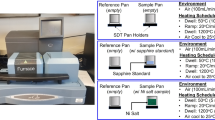Abstract
When niobium is heated in static air, layers of oxides and nitrides form on the surface, depending on the temperature. At 1150–1500°C, a layer of solid Nb2O5 forms with linear growth kinetics. At 1500–1900°C, a layer of Nb2N forms under a two-phase layer of liquid oxide+solid NbO2. The two-phase oxide layer has linear growth kinetics, while the Nb2N layer has parabolic kinetics. Above 1900°C, successive layers of Nb2N, NbN, and liquid oxide form, with both nitrides exhibiting parabolic growth kinetics. The activation energies of layer growth are as follows: Q=105 kJ/mol for Nb2O5, 120 kJ/mol for the two-phase oxide layer, and 220 kJ/mol for Nb2N (Q for liquid oxide and NbN layer formation was not determined). Above 1500°C, the nitride layers are somewhat protective, in that they slow the oxide formation rate and prevent ignition.
Similar content being viewed by others
References
P. Kofstad,High Temperature Corrosion (Elsevier Applied Science Publishers, Essex, England, 1988), p. 319.
J. W. Clark, inColumbium Metallurgy, D. L. Douglass and F. W. Kunz, eds. (Interscience Publishers, New York, 1961), pp. 615–647.
G. Z. Brauer,Z. Anorg. Chemie 248 (1941).
R. P. Elliott,Trans. ASM 52 (1959).
O. Kubaschewski and B. E. Hopkins, inNiobium, Tantalum, Molybdenum and Tungsten, A. G. Quarrel, ed. (Elsevier Publishing Company, New York, 1961), pp. 182–189.
R. P. Elliott and S. Komjathy, inColumbium Metallurgy, D. L. Douglass and F. W. Kunz, ed. (Interscience Publishers, New York, 1961), pp. 367–382.
N. Kieda, N. Mizutani, and M. Kato,Yogyo Kyokaishi 94, 1 (1986).
G. Z. Brauer and J. Jander,Z. Anorg. u. Allgem. Chem. 270 (1952).
Yu. V. Levinskiiet al., Izv. Akad. Nauk SSSR, Metal. 1 (1973).
G. V. Samsonov and I. M. Vinitskii,Handbook of Refractory Compounds (IFI/Plenum, New York, 1980), p. 222.
F. W. Wohlbier, ed.,Diffusion Data, Vol. 7, No. 4 (Diffusion Information Center, Cleveland, Ohio, 1973), p. 458.
E. A. Gulbransen and K. F. Andrew,Trans. AIME 188 (1950).
R. P. Elliott and S. Komjathy, in Niobium Phase Diagrams, Armour Research Foundation, USAEC Contract No. AT (11-1)-515 (May 15, 1960).
R. A. Pasternak, High Temperature Oxidation and Nitridation of Nb in Ultrahigh Vacuum, Final Report, July 1, 1963–October 31, 1964; NTIS order no. DE81026549:Con. Abstr., May 1982, p. 190, line 54.
N. Schonberg,Acta Chem. Scand. 8, 2 (1954).
G. Brauer, inNiobium, Tantalum, Molybdenum and Tungsten, A. G. Quarrell, ed. (Elsevier Publishing Company, New York, 1961), pp. 121–127.
K. K. Schulzeet al., J. Met. 40, 10 (1988).
E. T. Turkdogen,Physical Chemistry of High Temperature Technology (Academic Press, New York, 1980), p. 17.
C. Catella and R. Streiff,J. Electrochem. Soc. 118, 6 (1971).
Author information
Authors and Affiliations
Rights and permissions
About this article
Cite this article
Hennessey, T.P., Morral, J.E. Oxidation and nitridation of niobium in air above 1150°C. Oxid Met 38, 163–187 (1992). https://doi.org/10.1007/BF00665050
Received:
Revised:
Issue Date:
DOI: https://doi.org/10.1007/BF00665050



